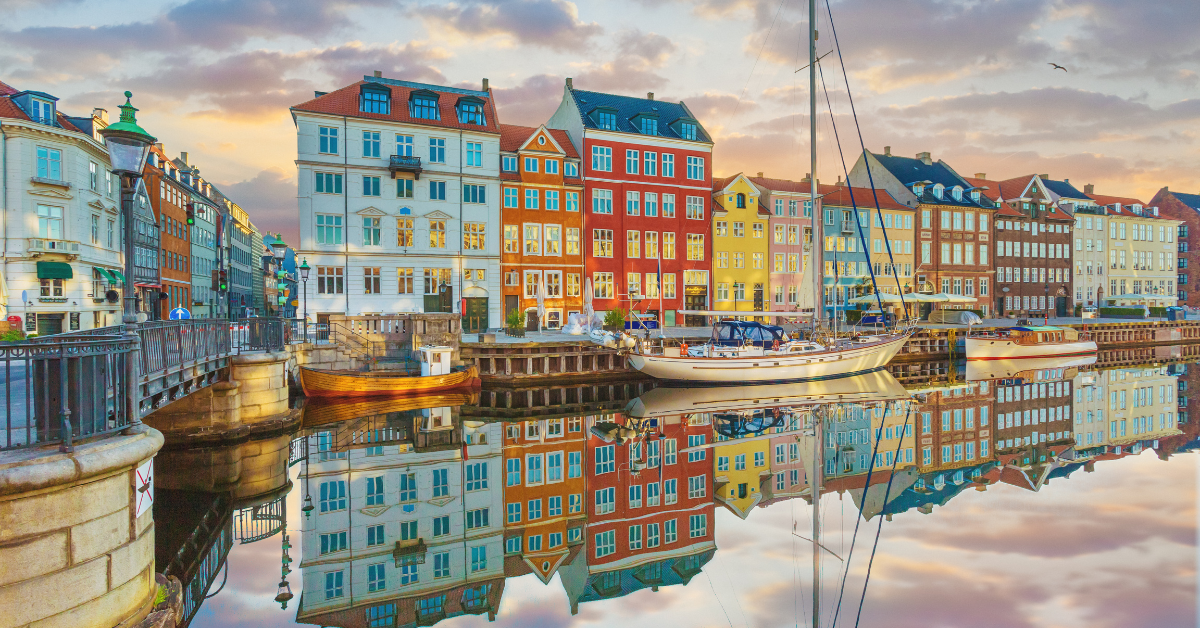The Danish capital, Copenhagen, has no official kanji representation in Japanese.
Written simply in katakana, the name conveys a sense of Scandinavian elegance through its sound alone.
Renowned for its design and sustainable city planning, the city has become a symbol of an ideal lifestyle for many Japanese people.
This article explores why kanji isn’t used, and how Japanese culture perceives Copenhagen through its aesthetics, lifestyle, and design.
Why Copenhagen Has No Kanji Representation
In Japanese, foreign place names are generally written phonetically in katakana.
Copenhagen follows this principle because translating its original meaning into kanji would distort its linguistic and cultural nuance.
| City Name | Meiji-era Form | Modern Form | Notes |
|---|---|---|---|
| London | 倫敦 | ロンドン | Early translations used kanji but later abandoned it |
| Paris | 巴里 | パリ | Sound-based katakana form became standard |
| Copenhagen | None | コペンハーゲン | No historical kanji version exists |
One of the main reasons is that the Danish term “Kjøbmandehavn” carries a complex and layered meaning.
The word combines “Kjøbmand” (merchant) and “havn” (harbor).
Translating it literally into Japanese, such as “商港” (commercial port), would lose the rich cultural and historical connotation of the original.
Therefore, the katakana form preserves both the sound and the essence of the city better than any direct translation could.
Copenhagen’s History and Culture as a Merchant City
Copenhagen has thrived as a center of trade and economy since the Middle Ages.
Situated between the North Sea and the Baltic Sea, it became a vital maritime trading hub, a role that continues to shape the city’s identity today.
| Era | Key Features | Urban Development |
|---|---|---|
| Medieval Period | Growth around port trade | Foundation as a commercial hub |
| Modern Era | Emergence as a cultural capital | Global recognition in design and education |
| Present Day | Realization of sustainable urban planning | Cycling culture and environmental innovation |
Over time, Copenhagen has evolved from a merchant city to a global model of sustainability.
The city’s emphasis on commerce, design, and education contributes to its citizens’ high level of happiness and quality of life.
How Japanese People Perceive Copenhagen
A Beautiful City of Scandinavian Design
For most Japanese people, “a beautifully designed city” is the first image that comes to mind when thinking of Copenhagen.
In the city center, colorful buildings line the Nyhavn waterfront, blending historic charm with modern architecture.
Copenhagen is also the heart of Scandinavian design, admired worldwide for its simplicity, quality, and functionality—values that resonate deeply with Japanese sensibilities.
| Japanese Impression | Specific Element | Shared Value |
|---|---|---|
| Calm, peaceful atmosphere | Wooden houses, warm lighting | Comfort and security |
| Refined design sense | Nordic furniture, architecture | Functional beauty and harmony |
| Fulfilled lifestyle | Hygge culture | Mindful happiness and balance |
The Danish concept of “Hygge”, meaning comfort and coziness, perfectly captures the essence of life in Copenhagen.
For many Japanese, this philosophy—valuing calmness and togetherness over busyness—is an ideal lifestyle worth aspiring to.
The Appeal of Copenhagen Through Sports
Cycling Culture and Environmental Awareness
Copenhagen is renowned as one of the world’s most bicycle-friendly cities.
Approximately 60 percent of its residents commute daily by bike, thanks to well-designed cycling infrastructure and strong safety awareness.
| Sports Element | Key Feature | Social Impact |
|---|---|---|
| Cycling | Promotes public health and sustainability | Reduces emissions and traffic congestion |
| Soccer | FC Copenhagen as a leading team | Strengthens local pride and identity |
| Water Sports | Canoeing and paddleboarding in the harbor | Combines recreation and tourism |
This coexistence of health consciousness and eco-awareness defines Copenhagen’s urban culture.
In this city, sports are not merely competition but a way of life, seamlessly integrated into everyday routines—a value that deeply appeals to many Japanese people.
Sports Events and Community Development
Sports in Copenhagen play an essential role in strengthening community bonds.
The city hosts marathons, cycling festivals, and beach volleyball tournaments that encourage participation from people of all ages.
| Event | Description | Social Impact |
|---|---|---|
| Copenhagen Marathon | Full marathon through the city | Promotes health and tourism |
| Tour de Copenhagen | Citizen cycling event | Enhances environmental awareness |
| Water Sports Festival | Held in harbor areas | Fosters local interaction and new tourism opportunities |
These initiatives reflect the city’s vision of “citizens as the core of urban life.”
Through sports, Copenhagen promotes well-being, inclusivity, and sustainability—making it a model for community-driven urban development recognized worldwide.
Cultural Similarities Between Japan and Copenhagen
Japan and Denmark share similar philosophies in craftsmanship, aesthetics, and lifestyle.
Both nations emphasize quality, simplicity, and harmony with nature, values deeply rooted in their cultures.
| Aspect | Japan | Denmark |
|---|---|---|
| Craftsmanship | Careful workmanship and durability | Minimalist, long-lasting design |
| Life Philosophy | Balance and calmness in daily life | Hygge and cozy living |
| Relationship with Nature | Respect for the seasons | Nature-inspired architecture and materials |
These similarities make Copenhagen feel like a distant yet familiar city to many Japanese people.
Both cultures value “small happiness in everyday life” and promote a simple, sustainable approach to living.
Conclusion
There is no official kanji representation for Copenhagen, and for good reason.
Rather than forcing a translation, preserving the sound, culture, and emotional resonance of the name allows its true meaning to shine through.
From its origins as a merchant port to its reputation for design, sustainable living, and sports, Copenhagen is a harmonious blend of culture, lifestyle, and physical vitality.
For Japanese people, it represents a model of simplicity, balance, and well-being—a city that continues to inspire the world by showing what it truly means to live beautifully.






